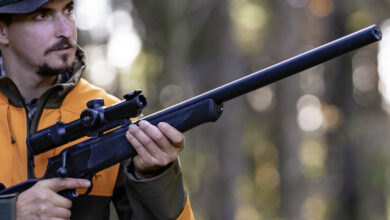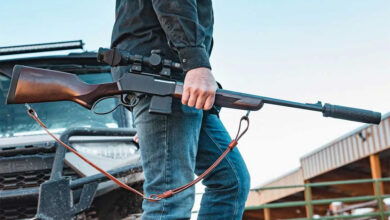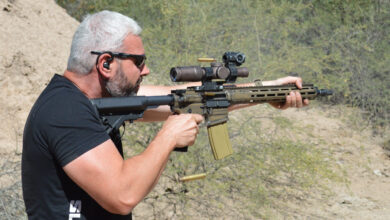Colt 1911 Government Model: The Quintessential .45

I am not, nor have I ever been, a big fan of 1911-style pistols. With that disclaimer out of the way, let me explain how I came back to the 1911. Of course, to outright dislike the Colt 1911 for its history is un-American. No one could ignore the fact that its design would go on to influence most handguns that currently exist. Even though I grew up during the age of the polymer-framed 9mm pistol, I think the case is easy to make for a 1911 today, even an eight-round version in .45 ACP.
My big problem with the M1911 is that there are too many of them out today. There are too many variations made by too many companies and all channel some amount of that misplaced nostalgia without earning it. Besides, there are plenty of other handguns from a similar vintage that are cool and influential, too. Still, no collection is complete without a 1911. But which one to get? A double-stack 2011 in 9mm? A version with high visibility sights or red dots? I decided to give a plain Jane Colt a chance. However, Colt 1911 pistols are not just the worn antiques of another time. Colt still makes them, and the Government Model is as close as one could get to what the US Cavalry adopted in 1911. But does the new model live up to the legacy?
Colt 1911: Features
The Colt Government Model that Colt currently catalogs is a little different from what was adopted in 1911. My Colt features a blued carbon steel slide, frame, controls, and a pair of checkered walnut grips. It dispenses with aggressive cocking serrations, ambidextrous buttons, light rails, and high visibility sights. The Colt Government Model ships with a standard hammer, magazine release, slide release, and manual thumb safety on the right side. The sights are in plain blue and have a higher profile than the virtually sightless original GI model. The rear sight is drift adjustable, but the front sight is staked in place.
The Colt Government Model also dispenses with the full-length guide rod and bull barrel on some new 1911s and 2011s. Opting for the original GI barrel bushing assembly and free-floating recoil spring. What you would not find on an old 1911, however, is the 5-inch Colt National Match barrel. Furthermore, the grip is a mishmash of features. The Government Model has a flat mainspring housing that originally debuted on the original 1911. The elongated grip safety, however, only shows up on the 1911A1 as modified in 1924. Although this model is available in .38 Super Auto, mine is chambered in .45 ACP and shipped with one seven-round Colt magazine.

Colt’s Government Model is what is termed a Series 70 pistol. Up through the 1970s, this was Colt’s default pattern. It used a short trigger and lacked a firing pin safety, features that carry over to this model. Later, Series 80 guns incorporated this extra drop safety feature and used a longer trigger unit. Taken together, Colt offers us a snapshot of what constituted a true 1911 platform before the platform became so modular and adaptive. But does that make it a bad shooter?
Disassembling The Colt 1911
Although it has a few extra pieces, the Colt Government Model is utterly familiar once it is apart. All the major parts of a modern service pistol are there but arranged in a way that will frustrate a casual shooter accustomed to a simpler design. The extra bits that don’t show up on a modern pistol, the barrel bushing and recoil spring plug, are the first to move for disassembly.
Step-By-Step
Depress the plug and rotate the bushing out of the way. The plug comes loose, and the tension from the recoil spring underneath is relaxed. From there, the slide is retracted until the rounded slot in the rear of the slide release is lined up with a corresponding cut in the slide. The slide release is pressed from the right side of the pistol, allowing you to wriggle it out of its place.
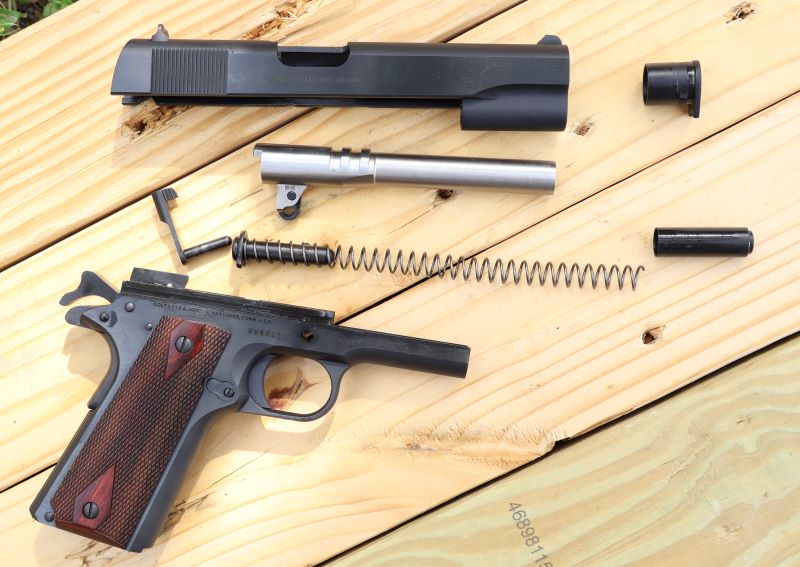
With the slide released, it can be removed from the pistol. The barrel bushing is rotated and pulled from the muzzle, followed by the barrel. Reassembly is as easy as going in reverse order. However, you have to remember that the swinging link under the barrel has to be down to mate it to the slide release. It is easy to scratch the pistol trying to get the slide release reinstalled.
You have to ensure the rounded nub of the slide release will land back in its slot with a straight push inward. This is compounded by the fact that new 1911 pistols tend to be tightly fitted. This Colt Government Model was no exception, and it took about a dozen reassemblies, with the persuasion of a plastic hammer, before I could work it in with thumb pressure.
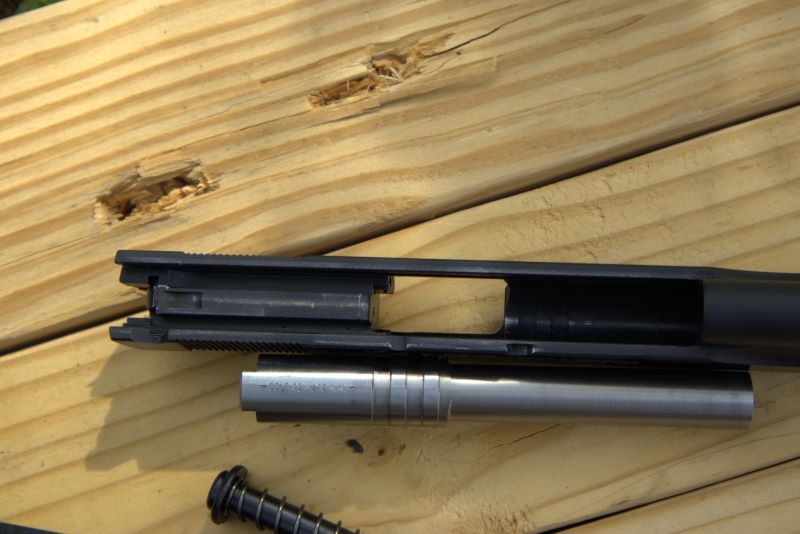
Disassembling a 1911 is worth the experience to see just how long pistols have come and marvel at the engineering involved. It also brings the chance to see just how Colt is making them these days. These are all CNC machined pistols, and this one does not have a single machine mark or burr, nor does it have much polish except for the sheen of the National Match barrel.
Quick Specs
- Model: Colt Government Model
- Caliber: .45 ACP
- Capacity: 7+1
- Barrel Length: 5 inches
- Overall Length: 8.75 inches
- Slide Width: .9 inch
- Overall Width: 1.36 inches
- Height: 5.25 inches
- Weight: 2 lbs. 11 oz. (loaded)
On the Range with the Colt Government Model
Everyone and their neighbor are making 1911-style pistols today. It is still a popular and adaptable design, but not all manufacturers are created equal. My time with 1911 pistols is a mixed bag between flawless function out of the box and a jam sandwich. This Colt Government Model falls into the former camp.
I warmed up to the Colt with some dry fire repetitions to get used to the short trigger and figure out where my finger should be placed to not disturb the sights. I tend to shoot with the crease of my index finger rather than the pad, which is great for double actions but scattershot with single actions. But a straight rearward press with the pad of my finger is exactly what I needed.
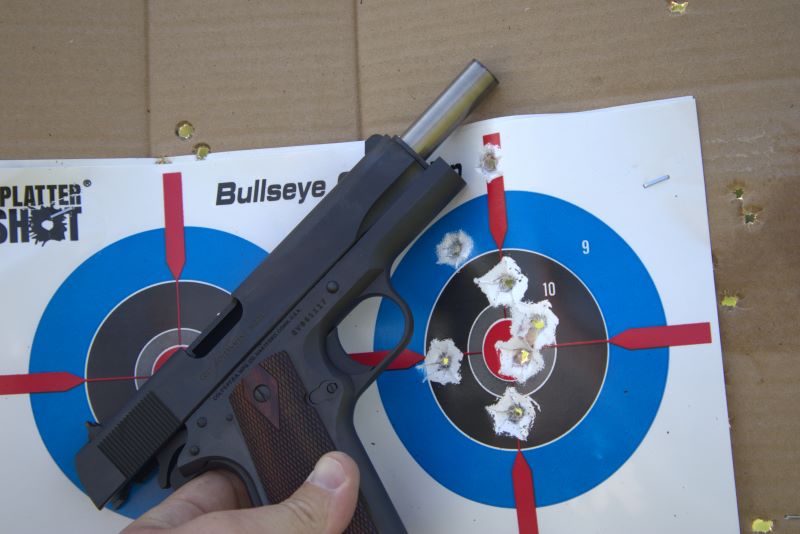
With that sorted out, I grabbed a few Colt magazines loaded with Winchester 230 grain FMJ ammo and tried to hit eight-inch steel plates at 30 yards. Using a six o’clock hold, I was able to hit them all without a miss. I expected to miss all of them, given these were my first shots. I next tried my luck on paper, at ten yards, to see exactly where the sights were hitting.
As long as I kept a consistent trigger pull, the rounds hit to the point of aim. I found I could reliably keep seven rounds into a two-inch pattern at that distance. I switched to lighter 185-grain PMC Bronze and Hornady Critical Defense hollow points as well as Speer Gold Dot 200-grain hollow points and did not perceive any shift in the point of impact. But I did perceive slightly less recoil.

Recoil
After shooting a lot of 9mm pistols, going up to a .45 ACP 1911 feels like a different experience in terms of recoil and overall shooting experience. Although the .45 is touted as a higher recoiling round, I was only able to perceive it when I shot it alongside my CZ-75 in 9mm. While the muzzle rise is a bit more than 9mm, the .45 is not as snappy. The recoil felt like a soft push, and you could feel the mechanism cycling. The larger round is betrayed by the Colt’s slimmer profile and the fact that the safety, slide release, and magazine release are well-appointed and easy to hit. While I am not a fan of serrated triggers, I had no issues with the one on the Colt. The trigger breaks clean at about 5 lbs. 3 oz. when measured on my Lyman trigger scale.
The only rub to shooting the Colt Government Model is that the web of my hand began to blister where the grip safety moves under recoil. Even with my beefier hands, the hammer never bit me.
Parting Shots
Although John Browning gets the credit for patenting what became the Colt 1911, Colt’s engineers and workmen had an expansive role in both the final design and its production of what would become an icon. Over a hundred years on, swimming in a sea of 1911s, it is easy to overlook Colt and it would be easy for Colt to not try as the 1911 has gone from a duty tool to a luxury good. If my work with this Colt Government Model has shown me anything, it is that Colt still produces an excellent 1911. Although I would have liked an extra magazine in the factory kit, the overall package is made with care and attention due to a legacy but with functionality in mind as well.
I am on three hundred rounds and counting and never had a failure to fire or feed. The sights, trigger, and controls are neither refined nor deficient. The Colt Government Model is a tinkerer’s dream, but on its own, it is a great 1911 to own if you are only going to own one. It is a pistol that is exciting and boring. Exciting because it is a Colt 1911 and boring because it hits targets and works as intended, as you would expect from what beat the competition to be America’s service handgun for seventy-five years. You can’t ask for much more than that.
The post Colt 1911 Government Model: The Quintessential .45 appeared first on The Mag Life.
Read the full article here

![Best .380 Pistol Options For Deep Carry [Tested] Best .380 Pistol Options For Deep Carry [Tested]](https://firearm-discounts.com/wp-content/uploads/2025/01/1736549812_380-Pistol-Sig-390x220.jpg)
